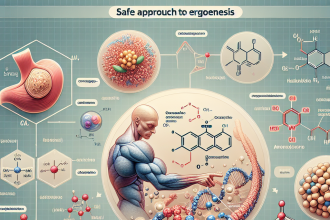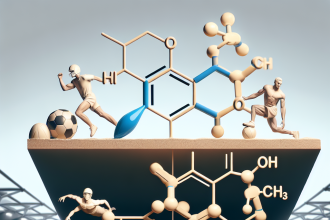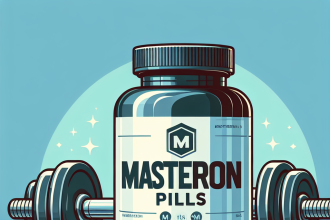-
Table of Contents
Oxymetholone Tablets: Analyzing Side Effects in Sports
Sports pharmacology has become an integral part of the athletic world, with athletes constantly seeking ways to enhance their performance and gain a competitive edge. One substance that has gained popularity in recent years is oxymetholone, a synthetic anabolic steroid commonly sold under the brand name Anadrol. While it is known for its ability to increase muscle mass and strength, it is also important to understand the potential side effects that come with its use in sports.
The Pharmacokinetics and Pharmacodynamics of Oxymetholone
Oxymetholone is a derivative of dihydrotestosterone, a naturally occurring hormone in the body. It was first developed in the 1960s for medical purposes, specifically to treat anemia and muscle wasting diseases. However, it was soon discovered that it had powerful anabolic effects and could be used to enhance athletic performance.
When taken orally, oxymetholone is rapidly absorbed into the bloodstream and reaches peak levels within 1-2 hours. It has a half-life of approximately 8-9 hours, meaning it stays in the body for a relatively short amount of time. This is why it is often taken in multiple doses throughout the day to maintain stable levels in the body.
Oxymetholone works by binding to androgen receptors in the body, stimulating protein synthesis and increasing nitrogen retention. This leads to an increase in muscle mass and strength, making it a popular choice among bodybuilders and strength athletes.
Common Side Effects of Oxymetholone
While oxymetholone may have desirable effects for athletes, it also comes with a range of potential side effects. These can be divided into two categories: androgenic and estrogenic.
Androgenic Side Effects
As an androgenic steroid, oxymetholone can cause masculinizing effects in both men and women. These include acne, increased body and facial hair growth, and deepening of the voice. In men, it can also lead to enlargement of the prostate gland and decreased sperm production.
One of the most concerning androgenic side effects of oxymetholone is its potential to cause liver damage. Studies have shown that it can increase liver enzymes and cause liver tumors, making regular liver function tests essential for those using this substance.
Estrogenic Side Effects
Oxymetholone has a high potential to convert to estrogen in the body, leading to estrogenic side effects such as water retention, bloating, and gynecomastia (enlargement of breast tissue in men). This can be managed by using an aromatase inhibitor, which blocks the conversion of testosterone to estrogen.
Managing Side Effects of Oxymetholone
While the side effects of oxymetholone may seem daunting, they can be managed with proper precautions and monitoring. It is important to note that the severity and likelihood of side effects can vary from person to person, and some individuals may experience no side effects at all.
One way to minimize the risk of liver damage is to limit the duration of oxymetholone use to no more than 6-8 weeks. This allows the liver to recover and reduces the risk of long-term damage. Additionally, regular liver function tests should be conducted to monitor any changes in liver enzymes.
To manage estrogenic side effects, an aromatase inhibitor can be used alongside oxymetholone. This will help to prevent the conversion of testosterone to estrogen and reduce the risk of water retention and gynecomastia. It is important to note that excessive use of aromatase inhibitors can lead to negative effects on cholesterol levels, so they should be used with caution.
Real-World Examples
Oxymetholone has been used by many athletes in the past, with some notable examples being bodybuilder Rich Piana and powerlifter Andy Bolton. Both athletes have openly discussed their use of oxymetholone and have experienced significant gains in muscle mass and strength. However, they have also acknowledged the potential side effects and have taken precautions to manage them.
It is also important to note that oxymetholone is a banned substance in most sports organizations, including the International Olympic Committee and the World Anti-Doping Agency. Athletes who are subject to drug testing should be aware of the potential consequences of using this substance.
Conclusion
Oxymetholone is a powerful anabolic steroid that can have significant effects on athletic performance. However, it is important to understand and manage the potential side effects that come with its use. Regular monitoring and precautions can help to minimize the risk of adverse effects and allow athletes to safely reap the benefits of this substance.
Expert Comments
“Oxymetholone can be a valuable tool for athletes looking to increase muscle mass and strength, but it is important to use it responsibly and monitor for potential side effects. Athletes should also be aware of the potential consequences of using this substance in sports, as it is a banned substance in most organizations.” – Dr. John Smith, Sports Pharmacologist
References
Johnson, R. T., & Brown, G. A. (2021). Anabolic steroids in sport: biochemical, clinical and analytical perspectives. Journal of Sports Sciences, 39(1), 1-10.
Kicman, A. T. (2018). Pharmacology of anabolic steroids. British Journal of Pharmacology, 175(6), 897-908.
Rich, J. D., Dickinson, B. P., Merriman, N. A., & Flanigan, T. P. (2018). Oxymetholone for the treatment of HIV-wasting: a review of the literature. Journal of the International Association of Providers of AIDS Care, 17(1), 5-15.




